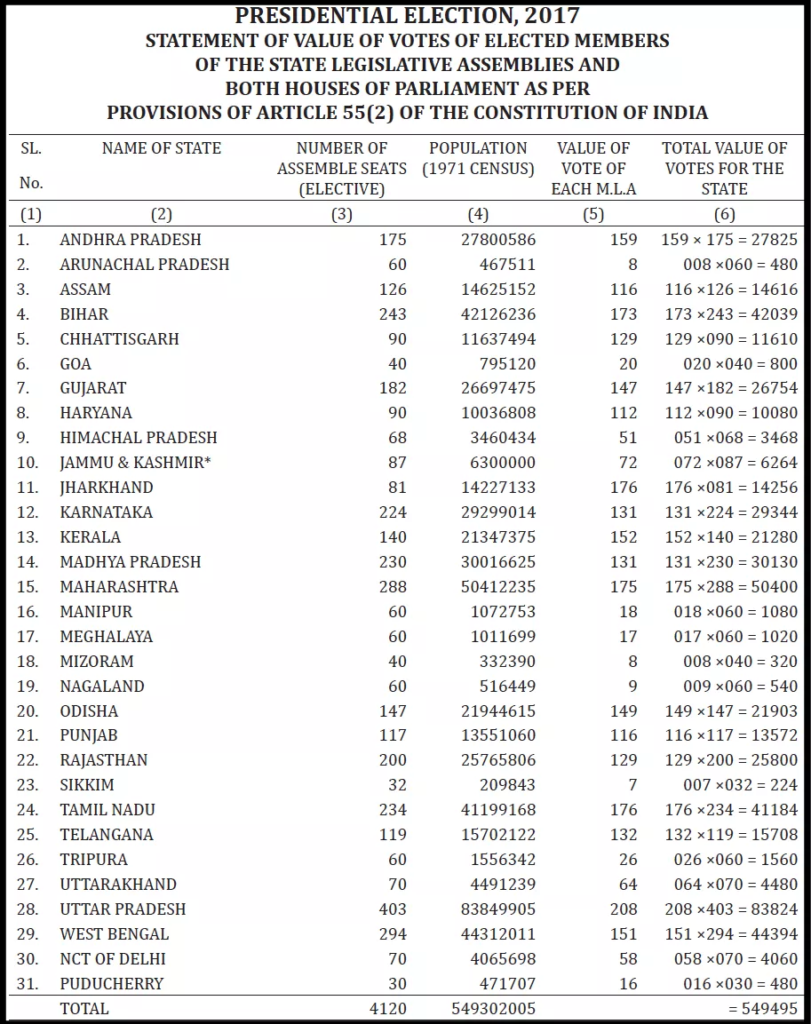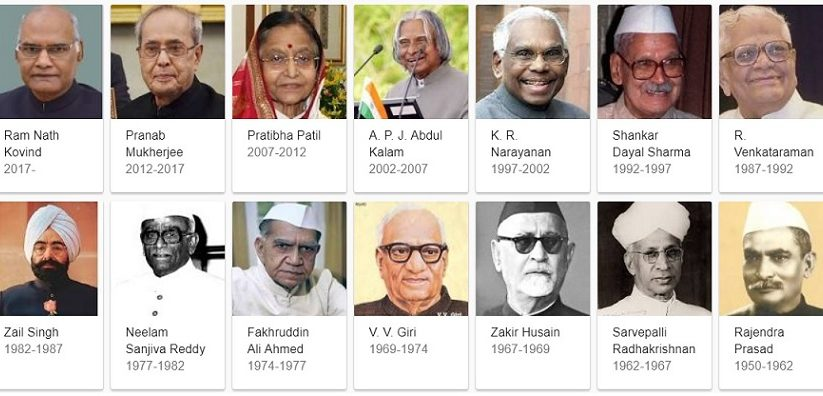Article 54 of the Constitution provides for an indirect method for the election of the President. By Article 54 the President shall be elected by the members of an electoral college consisting of the elected members of both Houses of Parliament; and the elected members of the Legislative Assemblies of the States
Thus by the Article 54 of the Constitution the electoral college for election of the President consists of (a) the elected members of both the Houses of the Union Parliament (All elected MPs), and (b) The elected members of all State Legislative Assemblies (All elected MLAs). The nominated members of the Parliament and Legislative Assemblies have been denied a share in the Presidential election.
Stages of Election of President
Stage 1: Notification of Election and Appointment of the Returning Officer:
The election is notified by the President and the responsibility for conducting it is with the Election Commission of India. The Election Commission appoints a Returning Officer. It also fixes the date for filing the nomination papers, the last date for withdrawal, and the polling schedule.
Stage 2: Filing of Nomination Papers, Scrutiny and Withdrawals:
By the stipulated date each candidate possessing the required qualification for the office of president has to file his nomination papers with the Returning Officer. Apart from the qualifications, the nomination paper of a candidate has to be signed by at least fifty (50) eligible voters as proposers and at least fifty(50) eligible voters as seconders. Here the voters are the MPs & MLAs and not citizens. A voter cannot propose or second more than one candidate. Each name has to be proposed by 50 electors and seconded by another 50 electors. Along with it, a sum of Rs. 15,000 has to be deposited as security money.
The nomination papers are then scrutinized for determining the eligibility of all candidates. All incomplete and wrong nominations get rejected. The candidates are then permitted to voluntarily withdraw from the contest by a stipulated date.
Stage 3: Election Campaign:
All eligible candidates conduct their election campaigns mostly through respective political parties supporting them. Since it remains confined only to the members of the Electoral College, the general public gets involved in a minimum way.
Stage 4: Polling:
On the fixed day, the polling is held. Each voter casts one vote and indicates his preferences on the ballot paper. The voting is totally secret.
The provisions of the anti-defection law are not applicable to the Presidential election. Hence the voters can vote according to their conscience and are not bound by any party whips. The voting is also by secret ballot
Principles for ensuring uniformity and parity in the value of votes of MPs and MLAs (Article 55):
Principle 1: Single Vote System:
In a Presidential election, each voter casts only one vote. However, the value of each vote differs from voter to voter. The value of vote of an MP is uniformly the same while the value of vote of an MLA differs from state to state. The value of votes of electors (voters) is basically determined on the basis of population of the States. Since population figures are dynamic and keep changing every year, it has been decided through the 84th Constitutional Amendment, that until the population figures for the first census after 2026 are published (in other words, 2031 census), the population of the States for the purpose of this calculation will mean the population as per the 1971 census.
Principle 2: There is uniformity in the scale of representation of all States:
The value of the vote of each MLA is calculated by dividing the population of the State as per 1971 Census, by the total number of elected members of the respective state assembly, and then to divide the quotient by 1000. Total Value of all members of each State Assembly is obtained by multiplying the number of seats in the Assembly by the number of votes for each member.
Value of vote of an MLA of a State = (Total Population of State/Number of Elected MLAs of State) ÷1000
Then the total value of votes of all the MLAs of all the States is aggregated. Let us calculate the value of the vote of MLA. from Maharashtra. Maharashtra Legislative Assembly has 288 members. According to census data, the population of Maharashtra was 50412235.
Thus the value of vote of M.L.A. of Maharashtra = (50412235/288)/1000 = 175
Thus total value of all Maharashtra State M.L.A.s = 175 x 288 = 50400
For 2017 presidential election value of each vote of M.L.A. of different states, the total value of votes of M.L.A. of a State and Total value of all the M.L.A.s of all the States are given in the following table.

Principle 3: There is parity in the value of votes of all MPs and all MLAs:
The total value of votes of all the States is divided by the total number of elected members of Parliament (Lok Sabha 543+Rajya Sabha 233) to get the value of votes of each Member of Parliament or the MP. The total value of votes of all the States is 549495.
Value of Vote of an MP = 549495/ (543 + 233) = 549495/ 776 = 708
Thus for 2017, the value of the vote of MP worked out to be 708.
Total value of votes of MP = 708 x 776 = 549408
Total value of votes of all MPs and MLAs = 549495 + 549408 = 1098903
The value of a MP vote is substantially higher than the value of a MLA vote.
Principle 4: Process of Election of President
A ballot paper is given to each voter with the names of the contesting candidates, green ballot paper for MPs & Pink ballot paper for MLAs. This election happens through the Single Transferable Vote (STV). Hence each voter can mark as many preferences, as the number of candidates contesting the election. These preferences for the candidates are to be marked by the voter, by marking the figures 1, 2, 3, 4, 5 and so on, against the names of the candidates, in the order of preference. The vote of voter goes to the candidate to whom he gives his first preference vote. But in case that candidate fails to win the required winning quota and no other candidate also gets the required winning quota of votes, his vote is transferred to the candidate to whom he has given his second preference vote and so on.
Principle 5: A Fixed Quota of Votes for a Win in Election of President:
To win a Presidential election, a candidate has to secure a minimum fixed quota of votes. It is calculated as follows
Winning Quota = Total number of valid votes Polled/ number of seats + 1
i.e., 50% of valid first preferential votes polled + 1.
Stage 5: Counting of Votes During Election of President:
The First count is done by counting the first preference votes secured by each candidate. If no candidate gets the required winning quota of votes in the First count, the candidate with the lowest number of votes polled gets eliminated. His votes are then transferred to the remaining candidates on the basis of the second preferences as recorded by ‘his voters’. The process is repeated until one of the contesting candidates secures the required winning quota. This transfer system was used only once at the time of the Fifth Presidential election held in 1969. It has not been used thereafter because each Presidential election has given a clear majority to one candidate.
A candidate who secures less than 1/6th of the votes necessary to win the election forfeits his security money.
Stage 6: Notification of the Result:
The result of the election is then notified in the Gazette of India.
Stage 7: Oath-taking and Installation (Article 60):
The day the term of the previous President expires or on a fixed date, the oath-taking and installation of the new President take place. The President-elect takes the oath of his office in the presence of the Chief Justice of India, and in his absence in the presence of the available senior-most judge of the Supreme Court.
Method of the settlement of disputes regarding the Presidential Election:
Any dispute arising out of the election of the President is enquired into and finally decided by the Supreme Court of India. An election petition can be filed only within 30 days of the declaration of the result. The Supreme Court then conducts the hearing and gives its verdict.
